Cultural and Social Diversity in Healthcare: Comparative Case Studies
VerifiedAdded on 2021/02/18
|12
|2743
|15
Case Study
AI Summary
This case study examines the impact of cultural and social diversity on healthcare, focusing on the Vietnamese and Irish communities in Australia. It explores the social determinants of health, risk factors, and health provision strategies for each group. The analysis covers economic stability, healthcare access, education, and social context, highlighting disparities and challenges faced by both communities. Risk factors such as diabetes, nutrition, heart disease, and mental illness are discussed, along with strategies to address these issues, including preventive measures, policy recommendations, and improvements to healthcare infrastructure. The study emphasizes the importance of understanding cultural values and beliefs to improve health outcomes and reduce health deficits. The conclusion underscores the significance of cultural sensitivity and tailored healthcare approaches in promoting equitable health outcomes for diverse populations.
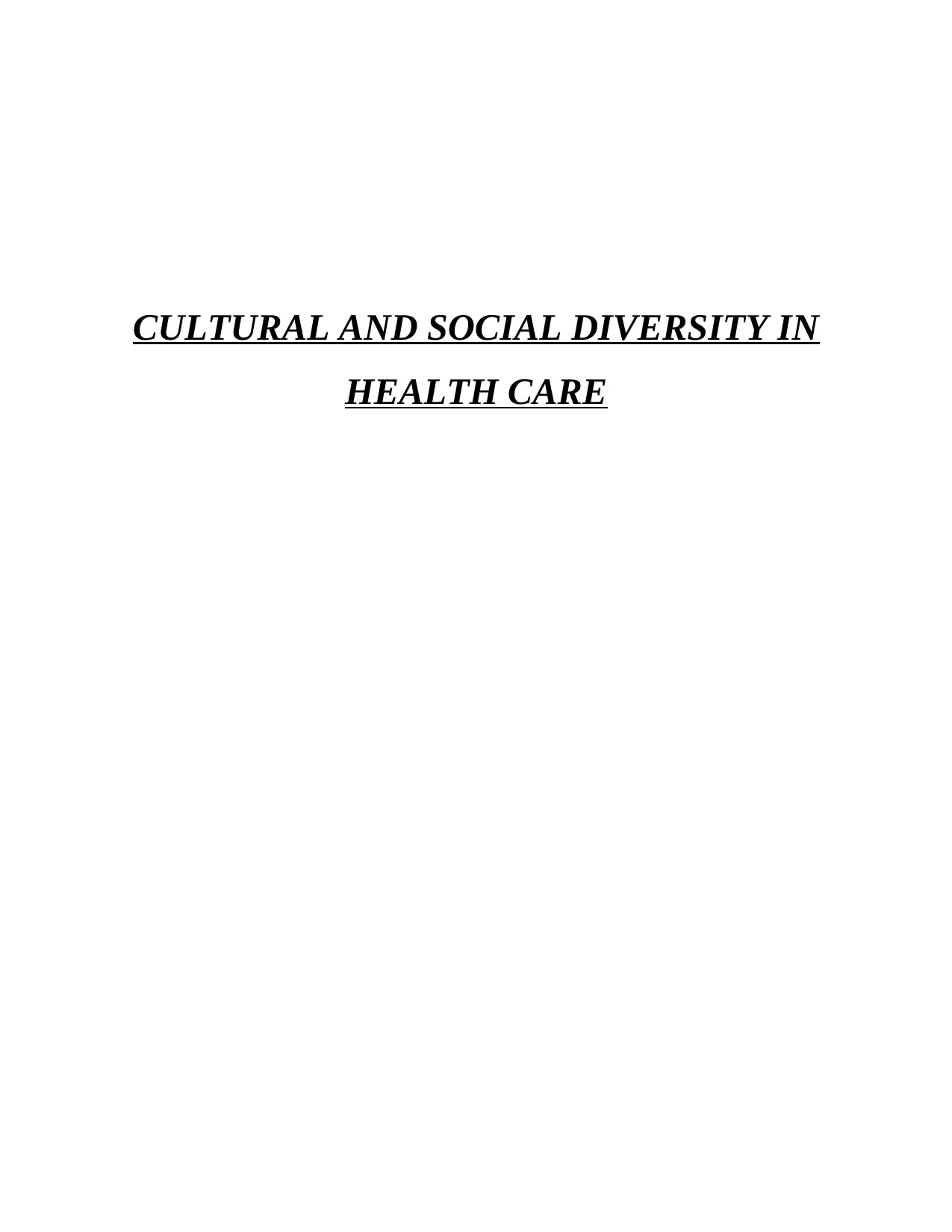
CULTURAL AND SOCIAL DIVERSITY IN
HEALTH CARE
HEALTH CARE
Paraphrase This Document
Need a fresh take? Get an instant paraphrase of this document with our AI Paraphraser
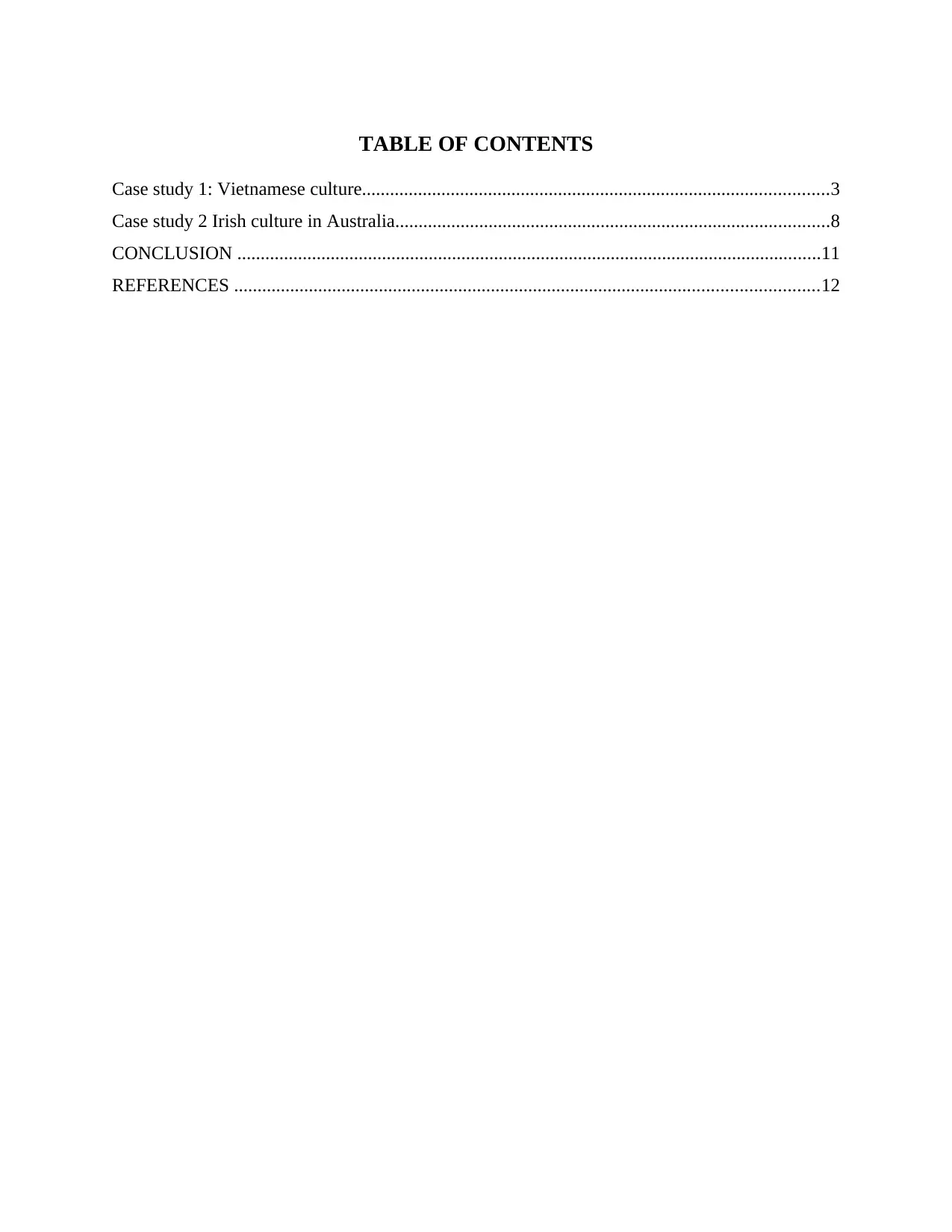
TABLE OF CONTENTS
Case study 1: Vietnamese culture....................................................................................................3
Case study 2 Irish culture in Australia.............................................................................................8
CONCLUSION .............................................................................................................................11
REFERENCES .............................................................................................................................12
Case study 1: Vietnamese culture....................................................................................................3
Case study 2 Irish culture in Australia.............................................................................................8
CONCLUSION .............................................................................................................................11
REFERENCES .............................................................................................................................12

Case study 1: Vietnamese culture
⊘ This is a preview!⊘
Do you want full access?
Subscribe today to unlock all pages.

Trusted by 1+ million students worldwide
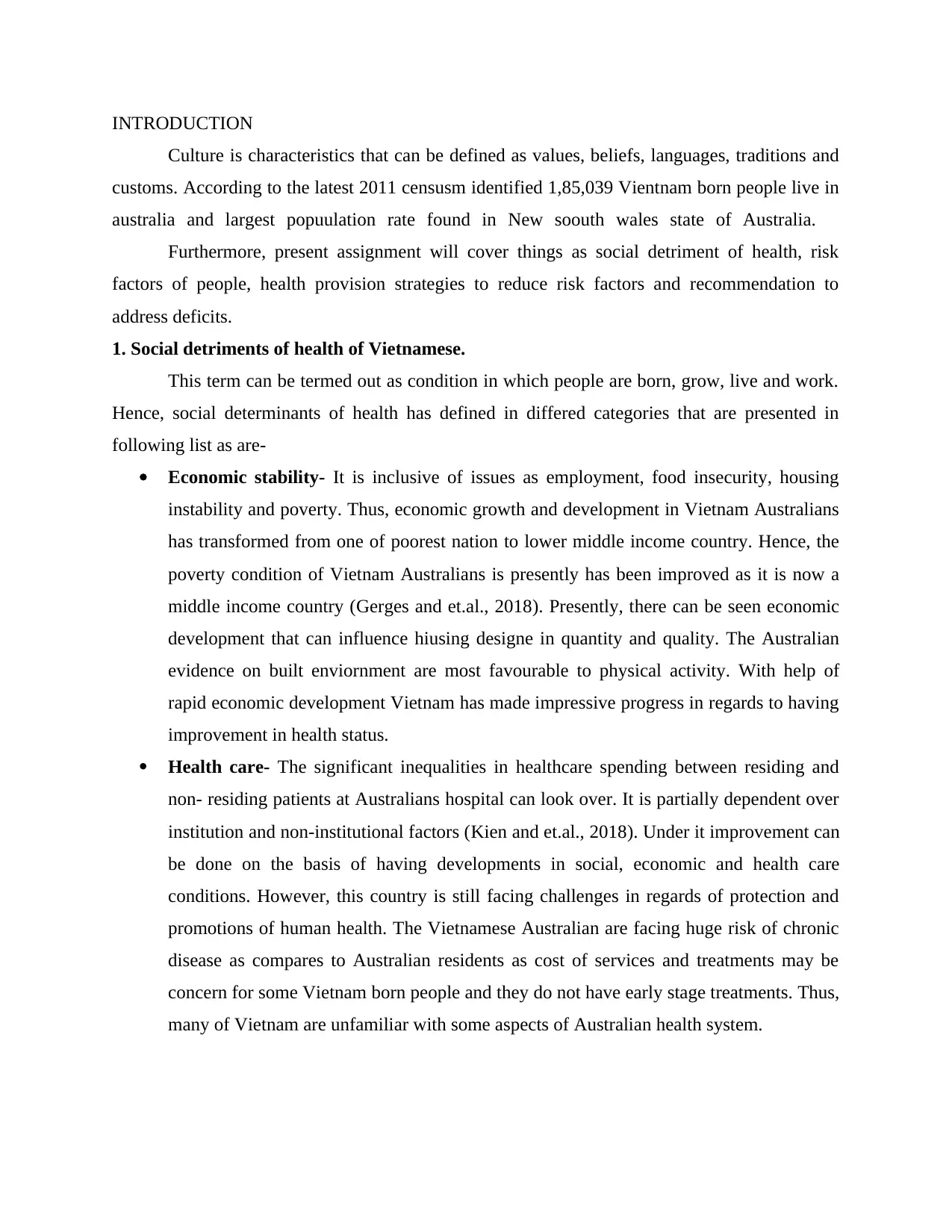
INTRODUCTION
Culture is characteristics that can be defined as values, beliefs, languages, traditions and
customs. According to the latest 2011 censusm identified 1,85,039 Vientnam born people live in
australia and largest popuulation rate found in New soouth wales state of Australia.
Furthermore, present assignment will cover things as social detriment of health, risk
factors of people, health provision strategies to reduce risk factors and recommendation to
address deficits.
1. Social detriments of health of Vietnamese.
This term can be termed out as condition in which people are born, grow, live and work.
Hence, social determinants of health has defined in differed categories that are presented in
following list as are-
Economic stability- It is inclusive of issues as employment, food insecurity, housing
instability and poverty. Thus, economic growth and development in Vietnam Australians
has transformed from one of poorest nation to lower middle income country. Hence, the
poverty condition of Vietnam Australians is presently has been improved as it is now a
middle income country (Gerges and et.al., 2018). Presently, there can be seen economic
development that can influence hiusing designe in quantity and quality. The Australian
evidence on built enviornment are most favourable to physical activity. With help of
rapid economic development Vietnam has made impressive progress in regards to having
improvement in health status.
Health care- The significant inequalities in healthcare spending between residing and
non- residing patients at Australians hospital can look over. It is partially dependent over
institution and non-institutional factors (Kien and et.al., 2018). Under it improvement can
be done on the basis of having developments in social, economic and health care
conditions. However, this country is still facing challenges in regards of protection and
promotions of human health. The Vietnamese Australian are facing huge risk of chronic
disease as compares to Australian residents as cost of services and treatments may be
concern for some Vietnam born people and they do not have early stage treatments. Thus,
many of Vietnam are unfamiliar with some aspects of Australian health system.
Culture is characteristics that can be defined as values, beliefs, languages, traditions and
customs. According to the latest 2011 censusm identified 1,85,039 Vientnam born people live in
australia and largest popuulation rate found in New soouth wales state of Australia.
Furthermore, present assignment will cover things as social detriment of health, risk
factors of people, health provision strategies to reduce risk factors and recommendation to
address deficits.
1. Social detriments of health of Vietnamese.
This term can be termed out as condition in which people are born, grow, live and work.
Hence, social determinants of health has defined in differed categories that are presented in
following list as are-
Economic stability- It is inclusive of issues as employment, food insecurity, housing
instability and poverty. Thus, economic growth and development in Vietnam Australians
has transformed from one of poorest nation to lower middle income country. Hence, the
poverty condition of Vietnam Australians is presently has been improved as it is now a
middle income country (Gerges and et.al., 2018). Presently, there can be seen economic
development that can influence hiusing designe in quantity and quality. The Australian
evidence on built enviornment are most favourable to physical activity. With help of
rapid economic development Vietnam has made impressive progress in regards to having
improvement in health status.
Health care- The significant inequalities in healthcare spending between residing and
non- residing patients at Australians hospital can look over. It is partially dependent over
institution and non-institutional factors (Kien and et.al., 2018). Under it improvement can
be done on the basis of having developments in social, economic and health care
conditions. However, this country is still facing challenges in regards of protection and
promotions of human health. The Vietnamese Australian are facing huge risk of chronic
disease as compares to Australian residents as cost of services and treatments may be
concern for some Vietnam born people and they do not have early stage treatments. Thus,
many of Vietnam are unfamiliar with some aspects of Australian health system.
Paraphrase This Document
Need a fresh take? Get an instant paraphrase of this document with our AI Paraphraser
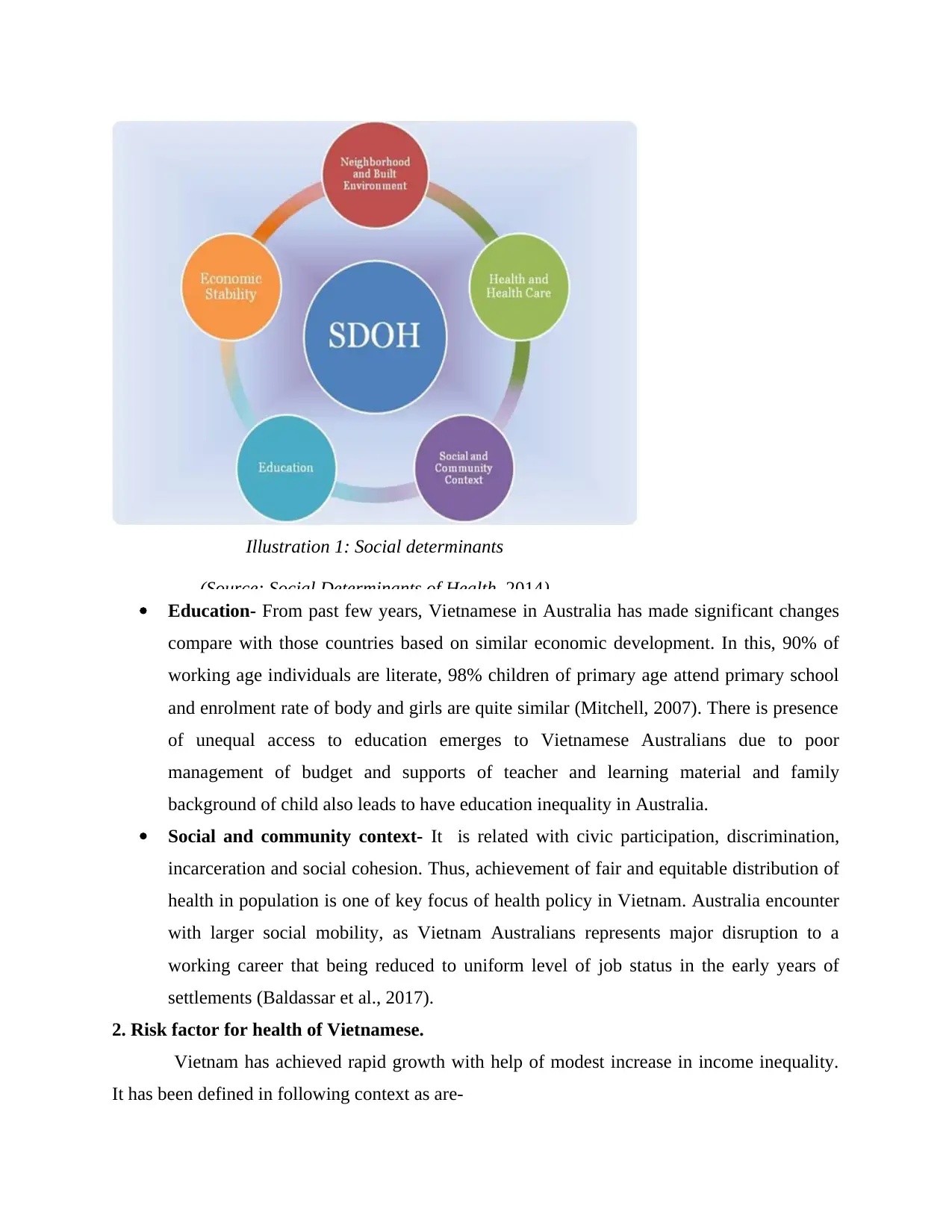
Illustration 1: Social determinants
(Source: Social Determinants of Health, 2014)
Education- From past few years, Vietnamese in Australia has made significant changes
compare with those countries based on similar economic development. In this, 90% of
working age individuals are literate, 98% children of primary age attend primary school
and enrolment rate of body and girls are quite similar (Mitchell, 2007). There is presence
of unequal access to education emerges to Vietnamese Australians due to poor
management of budget and supports of teacher and learning material and family
background of child also leads to have education inequality in Australia.
Social and community context- It is related with civic participation, discrimination,
incarceration and social cohesion. Thus, achievement of fair and equitable distribution of
health in population is one of key focus of health policy in Vietnam. Australia encounter
with larger social mobility, as Vietnam Australians represents major disruption to a
working career that being reduced to uniform level of job status in the early years of
settlements (Baldassar et al., 2017).
2. Risk factor for health of Vietnamese.
Vietnam has achieved rapid growth with help of modest increase in income inequality.
It has been defined in following context as are-
(Source: Social Determinants of Health, 2014)
Education- From past few years, Vietnamese in Australia has made significant changes
compare with those countries based on similar economic development. In this, 90% of
working age individuals are literate, 98% children of primary age attend primary school
and enrolment rate of body and girls are quite similar (Mitchell, 2007). There is presence
of unequal access to education emerges to Vietnamese Australians due to poor
management of budget and supports of teacher and learning material and family
background of child also leads to have education inequality in Australia.
Social and community context- It is related with civic participation, discrimination,
incarceration and social cohesion. Thus, achievement of fair and equitable distribution of
health in population is one of key focus of health policy in Vietnam. Australia encounter
with larger social mobility, as Vietnam Australians represents major disruption to a
working career that being reduced to uniform level of job status in the early years of
settlements (Baldassar et al., 2017).
2. Risk factor for health of Vietnamese.
Vietnam has achieved rapid growth with help of modest increase in income inequality.
It has been defined in following context as are-
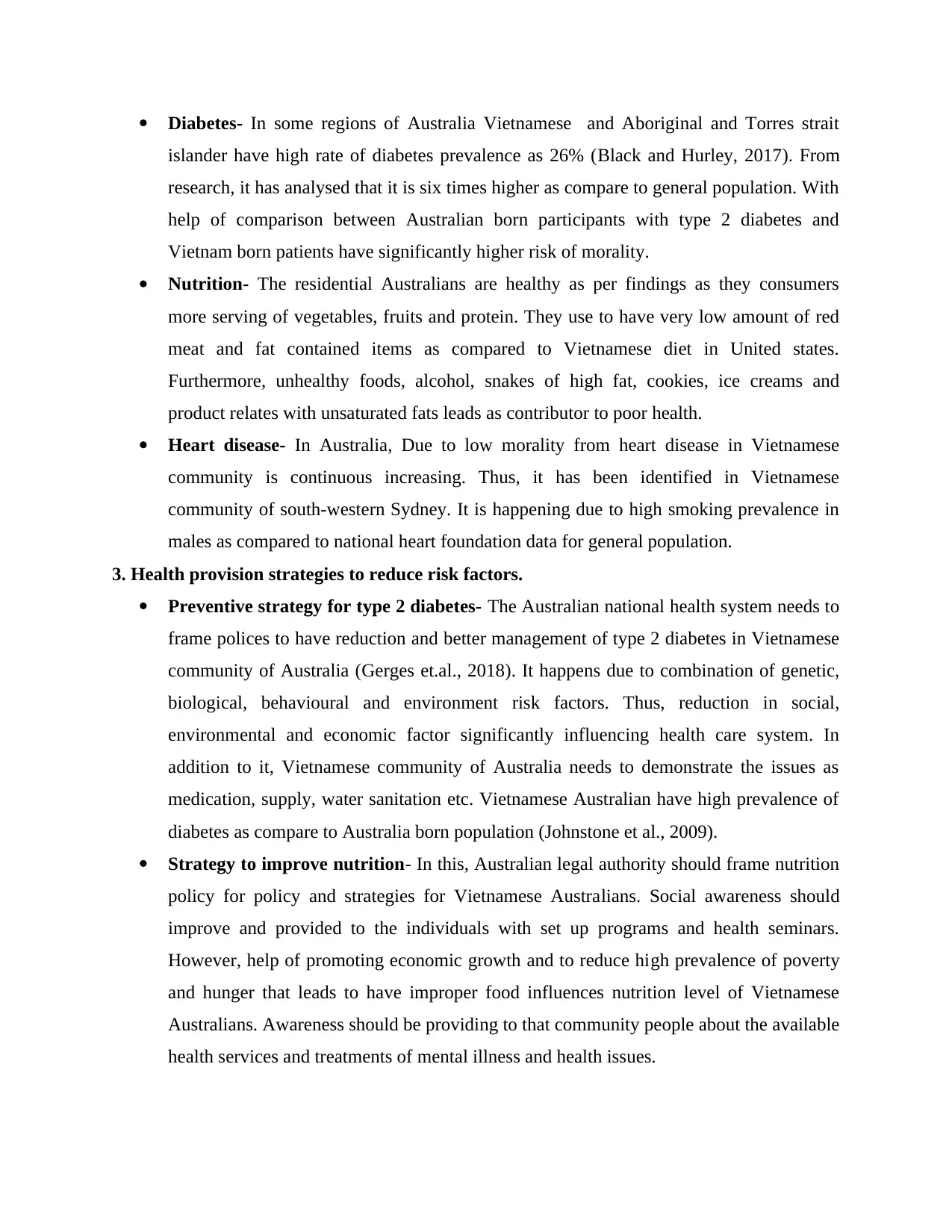
Diabetes- In some regions of Australia Vietnamese and Aboriginal and Torres strait
islander have high rate of diabetes prevalence as 26% (Black and Hurley, 2017). From
research, it has analysed that it is six times higher as compare to general population. With
help of comparison between Australian born participants with type 2 diabetes and
Vietnam born patients have significantly higher risk of morality.
Nutrition- The residential Australians are healthy as per findings as they consumers
more serving of vegetables, fruits and protein. They use to have very low amount of red
meat and fat contained items as compared to Vietnamese diet in United states.
Furthermore, unhealthy foods, alcohol, snakes of high fat, cookies, ice creams and
product relates with unsaturated fats leads as contributor to poor health.
Heart disease- In Australia, Due to low morality from heart disease in Vietnamese
community is continuous increasing. Thus, it has been identified in Vietnamese
community of south-western Sydney. It is happening due to high smoking prevalence in
males as compared to national heart foundation data for general population.
3. Health provision strategies to reduce risk factors.
Preventive strategy for type 2 diabetes- The Australian national health system needs to
frame polices to have reduction and better management of type 2 diabetes in Vietnamese
community of Australia (Gerges et.al., 2018). It happens due to combination of genetic,
biological, behavioural and environment risk factors. Thus, reduction in social,
environmental and economic factor significantly influencing health care system. In
addition to it, Vietnamese community of Australia needs to demonstrate the issues as
medication, supply, water sanitation etc. Vietnamese Australian have high prevalence of
diabetes as compare to Australia born population (Johnstone et al., 2009).
Strategy to improve nutrition- In this, Australian legal authority should frame nutrition
policy for policy and strategies for Vietnamese Australians. Social awareness should
improve and provided to the individuals with set up programs and health seminars.
However, help of promoting economic growth and to reduce high prevalence of poverty
and hunger that leads to have improper food influences nutrition level of Vietnamese
Australians. Awareness should be providing to that community people about the available
health services and treatments of mental illness and health issues.
islander have high rate of diabetes prevalence as 26% (Black and Hurley, 2017). From
research, it has analysed that it is six times higher as compare to general population. With
help of comparison between Australian born participants with type 2 diabetes and
Vietnam born patients have significantly higher risk of morality.
Nutrition- The residential Australians are healthy as per findings as they consumers
more serving of vegetables, fruits and protein. They use to have very low amount of red
meat and fat contained items as compared to Vietnamese diet in United states.
Furthermore, unhealthy foods, alcohol, snakes of high fat, cookies, ice creams and
product relates with unsaturated fats leads as contributor to poor health.
Heart disease- In Australia, Due to low morality from heart disease in Vietnamese
community is continuous increasing. Thus, it has been identified in Vietnamese
community of south-western Sydney. It is happening due to high smoking prevalence in
males as compared to national heart foundation data for general population.
3. Health provision strategies to reduce risk factors.
Preventive strategy for type 2 diabetes- The Australian national health system needs to
frame polices to have reduction and better management of type 2 diabetes in Vietnamese
community of Australia (Gerges et.al., 2018). It happens due to combination of genetic,
biological, behavioural and environment risk factors. Thus, reduction in social,
environmental and economic factor significantly influencing health care system. In
addition to it, Vietnamese community of Australia needs to demonstrate the issues as
medication, supply, water sanitation etc. Vietnamese Australian have high prevalence of
diabetes as compare to Australia born population (Johnstone et al., 2009).
Strategy to improve nutrition- In this, Australian legal authority should frame nutrition
policy for policy and strategies for Vietnamese Australians. Social awareness should
improve and provided to the individuals with set up programs and health seminars.
However, help of promoting economic growth and to reduce high prevalence of poverty
and hunger that leads to have improper food influences nutrition level of Vietnamese
Australians. Awareness should be providing to that community people about the available
health services and treatments of mental illness and health issues.
⊘ This is a preview!⊘
Do you want full access?
Subscribe today to unlock all pages.

Trusted by 1+ million students worldwide
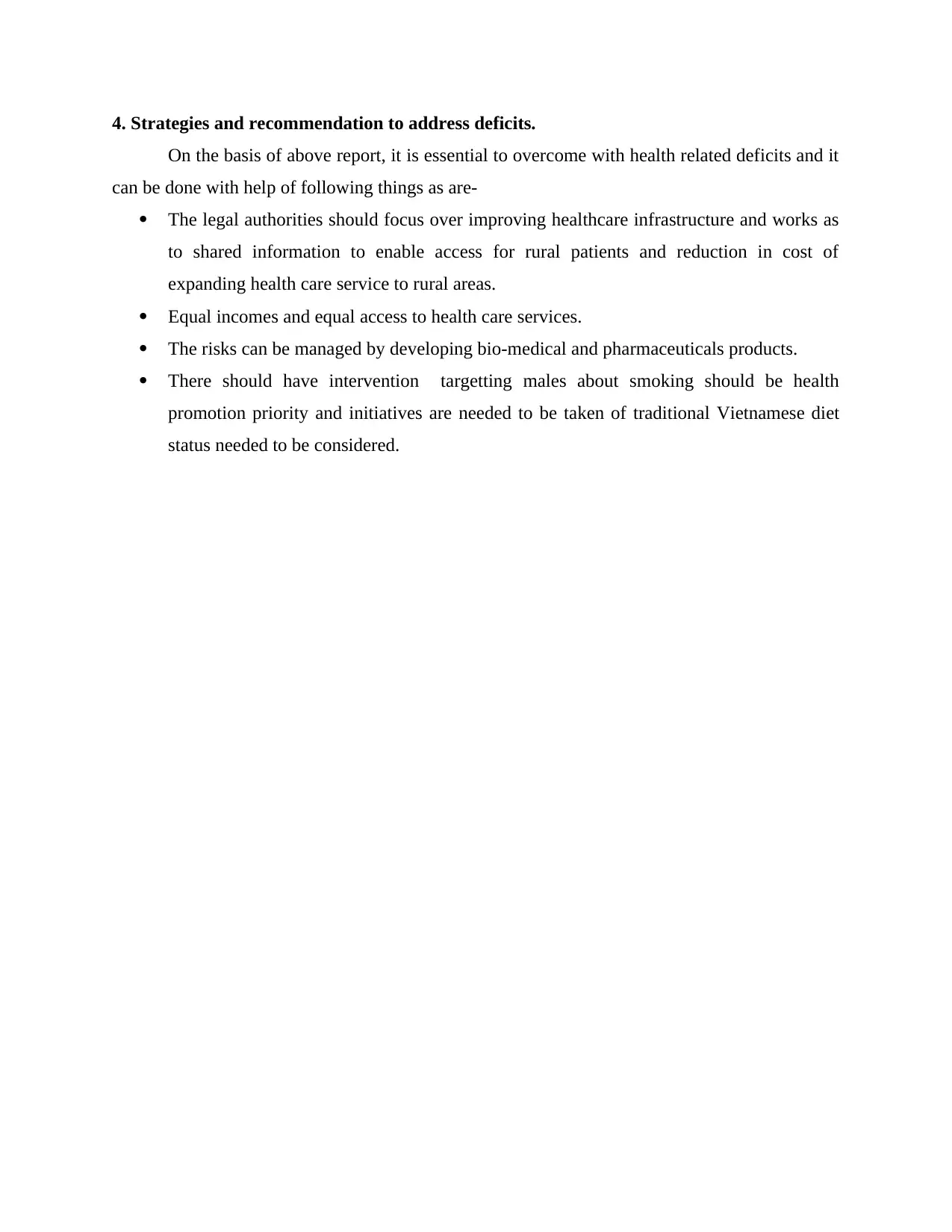
4. Strategies and recommendation to address deficits.
On the basis of above report, it is essential to overcome with health related deficits and it
can be done with help of following things as are-
The legal authorities should focus over improving healthcare infrastructure and works as
to shared information to enable access for rural patients and reduction in cost of
expanding health care service to rural areas.
Equal incomes and equal access to health care services.
The risks can be managed by developing bio-medical and pharmaceuticals products.
There should have intervention targetting males about smoking should be health
promotion priority and initiatives are needed to be taken of traditional Vietnamese diet
status needed to be considered.
On the basis of above report, it is essential to overcome with health related deficits and it
can be done with help of following things as are-
The legal authorities should focus over improving healthcare infrastructure and works as
to shared information to enable access for rural patients and reduction in cost of
expanding health care service to rural areas.
Equal incomes and equal access to health care services.
The risks can be managed by developing bio-medical and pharmaceuticals products.
There should have intervention targetting males about smoking should be health
promotion priority and initiatives are needed to be taken of traditional Vietnamese diet
status needed to be considered.
Paraphrase This Document
Need a fresh take? Get an instant paraphrase of this document with our AI Paraphraser

Case study 2 Irish culture in Australia
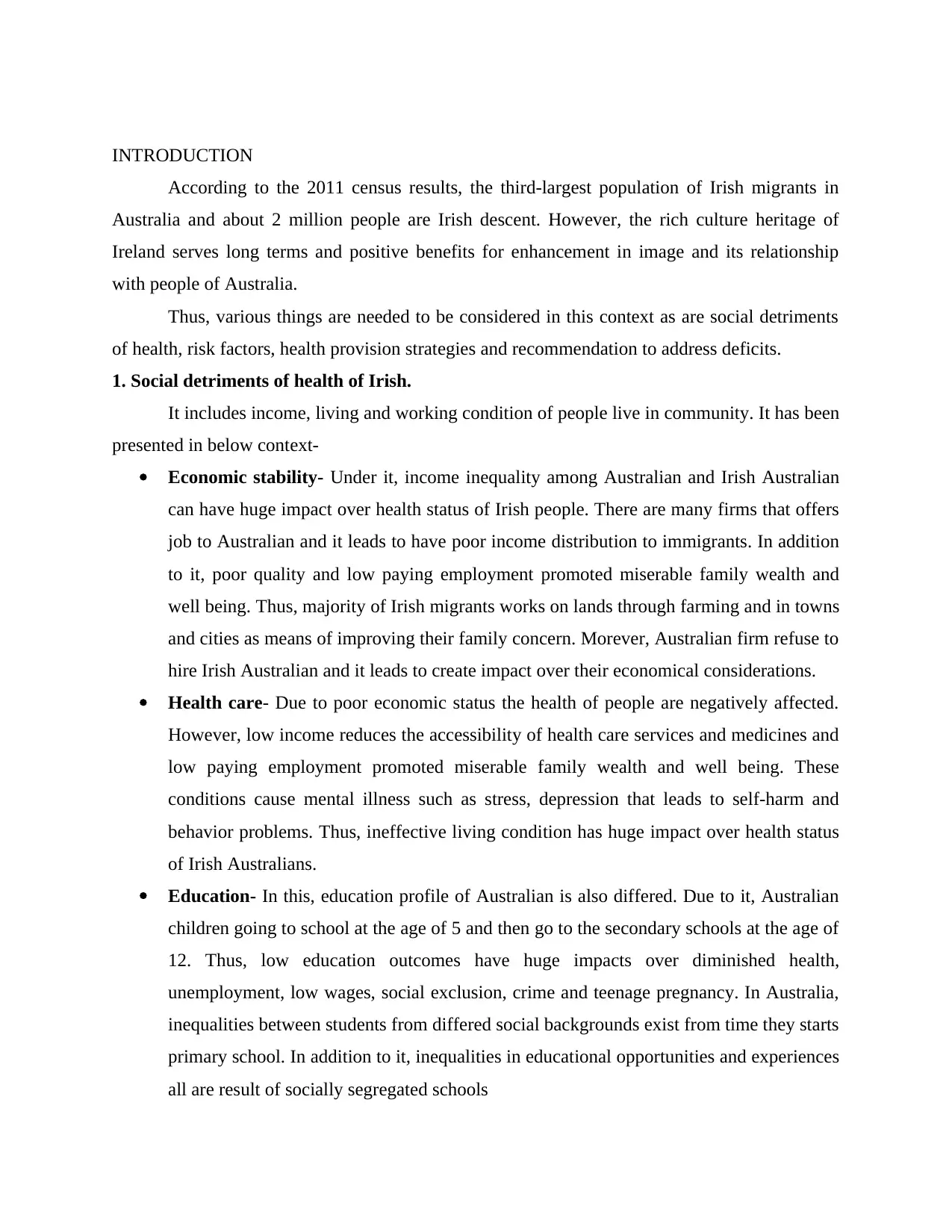
INTRODUCTION
According to the 2011 census results, the third-largest population of Irish migrants in
Australia and about 2 million people are Irish descent. However, the rich culture heritage of
Ireland serves long terms and positive benefits for enhancement in image and its relationship
with people of Australia.
Thus, various things are needed to be considered in this context as are social detriments
of health, risk factors, health provision strategies and recommendation to address deficits.
1. Social detriments of health of Irish.
It includes income, living and working condition of people live in community. It has been
presented in below context-
Economic stability- Under it, income inequality among Australian and Irish Australian
can have huge impact over health status of Irish people. There are many firms that offers
job to Australian and it leads to have poor income distribution to immigrants. In addition
to it, poor quality and low paying employment promoted miserable family wealth and
well being. Thus, majority of Irish migrants works on lands through farming and in towns
and cities as means of improving their family concern. Morever, Australian firm refuse to
hire Irish Australian and it leads to create impact over their economical considerations.
Health care- Due to poor economic status the health of people are negatively affected.
However, low income reduces the accessibility of health care services and medicines and
low paying employment promoted miserable family wealth and well being. These
conditions cause mental illness such as stress, depression that leads to self-harm and
behavior problems. Thus, ineffective living condition has huge impact over health status
of Irish Australians.
Education- In this, education profile of Australian is also differed. Due to it, Australian
children going to school at the age of 5 and then go to the secondary schools at the age of
12. Thus, low education outcomes have huge impacts over diminished health,
unemployment, low wages, social exclusion, crime and teenage pregnancy. In Australia,
inequalities between students from differed social backgrounds exist from time they starts
primary school. In addition to it, inequalities in educational opportunities and experiences
all are result of socially segregated schools
According to the 2011 census results, the third-largest population of Irish migrants in
Australia and about 2 million people are Irish descent. However, the rich culture heritage of
Ireland serves long terms and positive benefits for enhancement in image and its relationship
with people of Australia.
Thus, various things are needed to be considered in this context as are social detriments
of health, risk factors, health provision strategies and recommendation to address deficits.
1. Social detriments of health of Irish.
It includes income, living and working condition of people live in community. It has been
presented in below context-
Economic stability- Under it, income inequality among Australian and Irish Australian
can have huge impact over health status of Irish people. There are many firms that offers
job to Australian and it leads to have poor income distribution to immigrants. In addition
to it, poor quality and low paying employment promoted miserable family wealth and
well being. Thus, majority of Irish migrants works on lands through farming and in towns
and cities as means of improving their family concern. Morever, Australian firm refuse to
hire Irish Australian and it leads to create impact over their economical considerations.
Health care- Due to poor economic status the health of people are negatively affected.
However, low income reduces the accessibility of health care services and medicines and
low paying employment promoted miserable family wealth and well being. These
conditions cause mental illness such as stress, depression that leads to self-harm and
behavior problems. Thus, ineffective living condition has huge impact over health status
of Irish Australians.
Education- In this, education profile of Australian is also differed. Due to it, Australian
children going to school at the age of 5 and then go to the secondary schools at the age of
12. Thus, low education outcomes have huge impacts over diminished health,
unemployment, low wages, social exclusion, crime and teenage pregnancy. In Australia,
inequalities between students from differed social backgrounds exist from time they starts
primary school. In addition to it, inequalities in educational opportunities and experiences
all are result of socially segregated schools
⊘ This is a preview!⊘
Do you want full access?
Subscribe today to unlock all pages.

Trusted by 1+ million students worldwide

Social and community context- In this, substantially enhanced historical understanding
plays greater role. Irish Australian has lower civic participation and social cohesion
(Hepburn and et.al., 2015). Furthermore, social and economic conditions and impacts on
people lives determine the risk of illness. Due to different cultural beliefs and customs
some non-resident Irish Australian face social exclusion and lack of social support leads
to poor socio-economic status and psychological health issues.
2. Risk factors for health of people
Inequality in income, education and environmental factor leads to create huge impact
over health status of non residential Australians. It has been defined in following context as are-
Chronic disease- In this, Irish immigrants faces the high rate of chronic disease as cancer etc. It
happens due to excessive consumption of smoking, alcohol use and overweight etc (Hepburn and
et.al., 2015). Irish Australians consumes smoke as compare to Australian born participants. Due
to not getting early treatment of disease leads to convert in chronic disease. Due to ineffective
income distribution they do not get early stage treatment.
Mental illness- Irish community in Australia are suffering from high level of stress and that
significantly impacts their health status. Thus, financial burden are major source for Irish
Australians. They worries about getting job, monthly rent payments of house and car etc. This
issues leads to create mental health related issues. These poor health condition create serious
concern about the family well-being. Due to increase stress of unemployment or poor fiancial
conditions individual feels hopeless and may adapt bad habits such as alcohol addiction and
smoking to relive depression. Morever, violence anuse behaviour is also serious results of this
prolong stress.
3. Health provision strategies for Irish.
In order to get overcome with risk factor of health on Irish immigrants in Australia, the
various strategies has to be discussed as are-
1. Prevention strategy for chronic disease- Australian legal authority need to frame
national prevention strategy. To improve chronic disease as essential to provide equal
care to residential and non residential Australians. Provide guidance and proper
awareness among Irish people to use local and public health centers and services. It can
be done with help of overarching framework for agreed national directions for
improvement in chronic disease across Australia and among Irish immigrants.
plays greater role. Irish Australian has lower civic participation and social cohesion
(Hepburn and et.al., 2015). Furthermore, social and economic conditions and impacts on
people lives determine the risk of illness. Due to different cultural beliefs and customs
some non-resident Irish Australian face social exclusion and lack of social support leads
to poor socio-economic status and psychological health issues.
2. Risk factors for health of people
Inequality in income, education and environmental factor leads to create huge impact
over health status of non residential Australians. It has been defined in following context as are-
Chronic disease- In this, Irish immigrants faces the high rate of chronic disease as cancer etc. It
happens due to excessive consumption of smoking, alcohol use and overweight etc (Hepburn and
et.al., 2015). Irish Australians consumes smoke as compare to Australian born participants. Due
to not getting early treatment of disease leads to convert in chronic disease. Due to ineffective
income distribution they do not get early stage treatment.
Mental illness- Irish community in Australia are suffering from high level of stress and that
significantly impacts their health status. Thus, financial burden are major source for Irish
Australians. They worries about getting job, monthly rent payments of house and car etc. This
issues leads to create mental health related issues. These poor health condition create serious
concern about the family well-being. Due to increase stress of unemployment or poor fiancial
conditions individual feels hopeless and may adapt bad habits such as alcohol addiction and
smoking to relive depression. Morever, violence anuse behaviour is also serious results of this
prolong stress.
3. Health provision strategies for Irish.
In order to get overcome with risk factor of health on Irish immigrants in Australia, the
various strategies has to be discussed as are-
1. Prevention strategy for chronic disease- Australian legal authority need to frame
national prevention strategy. To improve chronic disease as essential to provide equal
care to residential and non residential Australians. Provide guidance and proper
awareness among Irish people to use local and public health centers and services. It can
be done with help of overarching framework for agreed national directions for
improvement in chronic disease across Australia and among Irish immigrants.
Paraphrase This Document
Need a fresh take? Get an instant paraphrase of this document with our AI Paraphraser
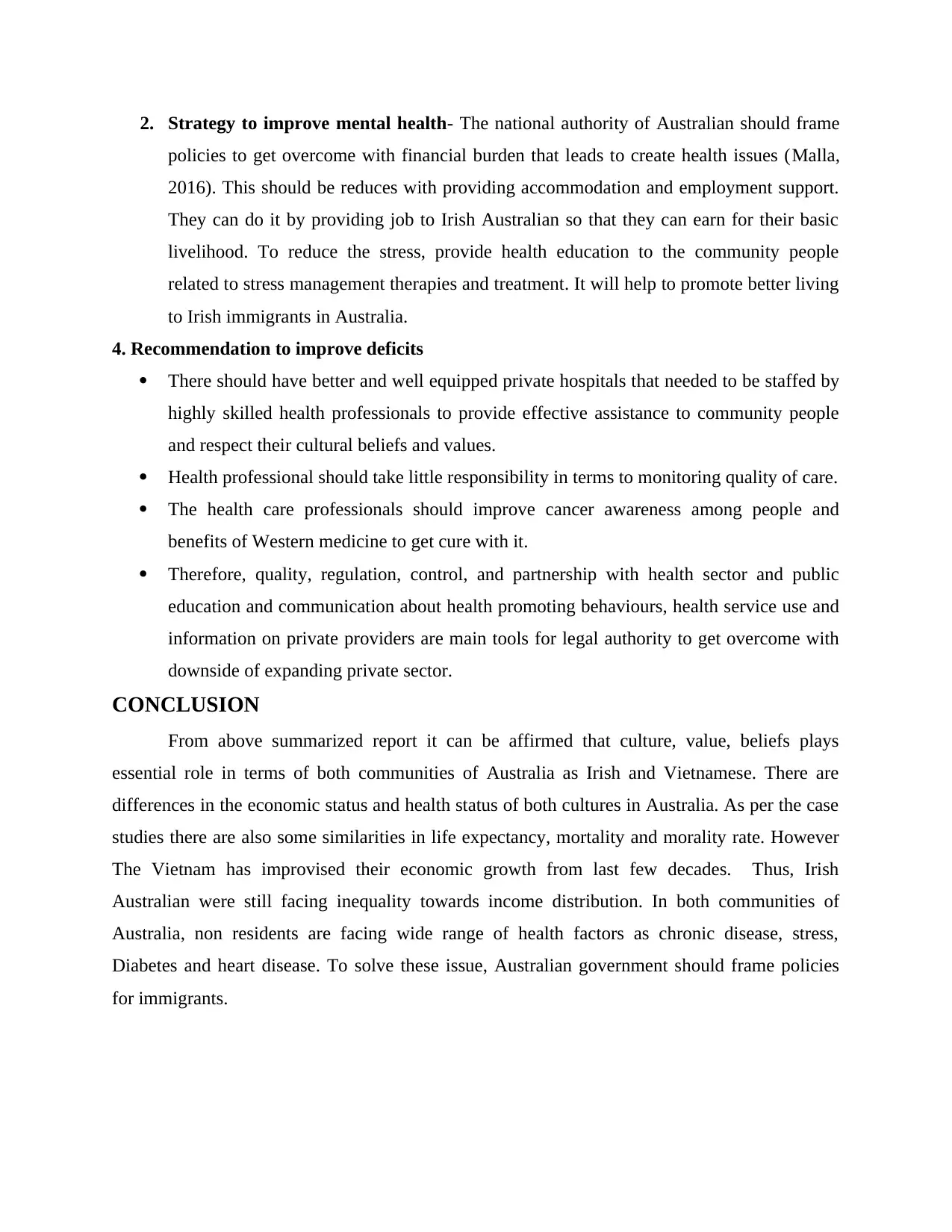
2. Strategy to improve mental health- The national authority of Australian should frame
policies to get overcome with financial burden that leads to create health issues (Malla,
2016). This should be reduces with providing accommodation and employment support.
They can do it by providing job to Irish Australian so that they can earn for their basic
livelihood. To reduce the stress, provide health education to the community people
related to stress management therapies and treatment. It will help to promote better living
to Irish immigrants in Australia.
4. Recommendation to improve deficits
There should have better and well equipped private hospitals that needed to be staffed by
highly skilled health professionals to provide effective assistance to community people
and respect their cultural beliefs and values.
Health professional should take little responsibility in terms to monitoring quality of care.
The health care professionals should improve cancer awareness among people and
benefits of Western medicine to get cure with it.
Therefore, quality, regulation, control, and partnership with health sector and public
education and communication about health promoting behaviours, health service use and
information on private providers are main tools for legal authority to get overcome with
downside of expanding private sector.
CONCLUSION
From above summarized report it can be affirmed that culture, value, beliefs plays
essential role in terms of both communities of Australia as Irish and Vietnamese. There are
differences in the economic status and health status of both cultures in Australia. As per the case
studies there are also some similarities in life expectancy, mortality and morality rate. However
The Vietnam has improvised their economic growth from last few decades. Thus, Irish
Australian were still facing inequality towards income distribution. In both communities of
Australia, non residents are facing wide range of health factors as chronic disease, stress,
Diabetes and heart disease. To solve these issue, Australian government should frame policies
for immigrants.
policies to get overcome with financial burden that leads to create health issues (Malla,
2016). This should be reduces with providing accommodation and employment support.
They can do it by providing job to Irish Australian so that they can earn for their basic
livelihood. To reduce the stress, provide health education to the community people
related to stress management therapies and treatment. It will help to promote better living
to Irish immigrants in Australia.
4. Recommendation to improve deficits
There should have better and well equipped private hospitals that needed to be staffed by
highly skilled health professionals to provide effective assistance to community people
and respect their cultural beliefs and values.
Health professional should take little responsibility in terms to monitoring quality of care.
The health care professionals should improve cancer awareness among people and
benefits of Western medicine to get cure with it.
Therefore, quality, regulation, control, and partnership with health sector and public
education and communication about health promoting behaviours, health service use and
information on private providers are main tools for legal authority to get overcome with
downside of expanding private sector.
CONCLUSION
From above summarized report it can be affirmed that culture, value, beliefs plays
essential role in terms of both communities of Australia as Irish and Vietnamese. There are
differences in the economic status and health status of both cultures in Australia. As per the case
studies there are also some similarities in life expectancy, mortality and morality rate. However
The Vietnam has improvised their economic growth from last few decades. Thus, Irish
Australian were still facing inequality towards income distribution. In both communities of
Australia, non residents are facing wide range of health factors as chronic disease, stress,
Diabetes and heart disease. To solve these issue, Australian government should frame policies
for immigrants.

REFERENCES
Baldassar, L., Pyke, J. and Ben-Moshe, D., 2017. The Vietnamese in Australia: diaspora identity,
intra-group tensions, transnational ties and ‘victim’status. Journal of Ethnic and Migration
Studies. 43(6). pp.937-955.
Gerges, M and et.al., 2018. Exploring levels and correlates of health literacy in Arabic and
Vietnamese immigrant patients with cancer and their English-speaking counterparts in
Australia: a cross-sectional study protocol. BMJ open. 8(7). p.e021666.
Johnstone, M J, & Kanitsaki, O. (2009). Ethics and advance care planning in a culturally diverse
society. Journal of Transcultural Nursing, 20(4), 405-416
Kien, V.D and et.al., 2018. Views by health professionals on the responsiveness of commune
health stations regarding non-communicable diseases in urban Hanoi, Vietnam: a
qualitative study. BMC health services research. 18(1). p.392.
Black, M.M. and Hurley, K.M., 2017. Responsive feeding: strategies to promote healthy
mealtime interactions. In Complementary feeding: building the foundations for a healthy
life. Karger Publishers.
Mitchell, J. (2007). History. In B. Carson., T. Dunbar., R. D. Chenhall., & R Bailie.(Eds.). Social
determinants of Indigenous health.
Malla, A and et.al., 2016. From early intervention in psychosis to youth mental health reform: a
review of the evolution and transformation of mental health services for young
people. Social psychiatry and psychiatric epidemiology. 51(3). pp.319-326.
Hepburn, C.M and et.al., 2015. Health system strategies supporting transition to adult
care. Archives of disease in childhood.
Sullivan, R. and Sullivan, R., 2018. Memorialising Irish Australians in Brisbane, 1872-
2017. Queensland History Journal. 23(10). p.666.
Molloy, K., 2016. Tradition, memory and the culture of Irish-Australian identity, 1900-
1960. Australasian Journal of Irish Studies, The. 16. p.47.
Online
Social Determinants of Health. 2014. [online] Available
through:<https://www.healthypeople.gov/2020/topics-objectives/topic/social-
determinants-of-health>.
Baldassar, L., Pyke, J. and Ben-Moshe, D., 2017. The Vietnamese in Australia: diaspora identity,
intra-group tensions, transnational ties and ‘victim’status. Journal of Ethnic and Migration
Studies. 43(6). pp.937-955.
Gerges, M and et.al., 2018. Exploring levels and correlates of health literacy in Arabic and
Vietnamese immigrant patients with cancer and their English-speaking counterparts in
Australia: a cross-sectional study protocol. BMJ open. 8(7). p.e021666.
Johnstone, M J, & Kanitsaki, O. (2009). Ethics and advance care planning in a culturally diverse
society. Journal of Transcultural Nursing, 20(4), 405-416
Kien, V.D and et.al., 2018. Views by health professionals on the responsiveness of commune
health stations regarding non-communicable diseases in urban Hanoi, Vietnam: a
qualitative study. BMC health services research. 18(1). p.392.
Black, M.M. and Hurley, K.M., 2017. Responsive feeding: strategies to promote healthy
mealtime interactions. In Complementary feeding: building the foundations for a healthy
life. Karger Publishers.
Mitchell, J. (2007). History. In B. Carson., T. Dunbar., R. D. Chenhall., & R Bailie.(Eds.). Social
determinants of Indigenous health.
Malla, A and et.al., 2016. From early intervention in psychosis to youth mental health reform: a
review of the evolution and transformation of mental health services for young
people. Social psychiatry and psychiatric epidemiology. 51(3). pp.319-326.
Hepburn, C.M and et.al., 2015. Health system strategies supporting transition to adult
care. Archives of disease in childhood.
Sullivan, R. and Sullivan, R., 2018. Memorialising Irish Australians in Brisbane, 1872-
2017. Queensland History Journal. 23(10). p.666.
Molloy, K., 2016. Tradition, memory and the culture of Irish-Australian identity, 1900-
1960. Australasian Journal of Irish Studies, The. 16. p.47.
Online
Social Determinants of Health. 2014. [online] Available
through:<https://www.healthypeople.gov/2020/topics-objectives/topic/social-
determinants-of-health>.
⊘ This is a preview!⊘
Do you want full access?
Subscribe today to unlock all pages.

Trusted by 1+ million students worldwide
1 out of 12
Related Documents
Your All-in-One AI-Powered Toolkit for Academic Success.
+13062052269
info@desklib.com
Available 24*7 on WhatsApp / Email
![[object Object]](/_next/static/media/star-bottom.7253800d.svg)
Unlock your academic potential
Copyright © 2020–2025 A2Z Services. All Rights Reserved. Developed and managed by ZUCOL.





